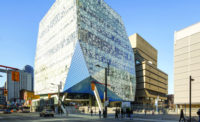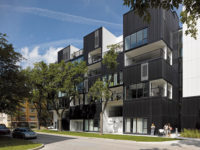Auburn, Washington
When the U.S. government subjugated Native American territories in the 19th century, the loss of communality was one of the most destructive consequences. With the tribes’ traditional ways of living, working, and celebrating together severely curtailed or outlawed, communal architecture, exemplified by the longhouse, became untenable. But in recent decades, the Muckleshoot Indian Tribe of the Pacific Northwest, like many others, has been reacquiring their lands, rebuilding, and restoring their traditions and rituals. The Muckleshoot’s new Smokehouse, built on their reservation near Tacoma, Washington, marks the tribe’s first longhouse in over a century.
The Muckleshoot chose the form of a longhouse, a building type designed for winter reunion, which is at the heart of the Smokehouse faith. Usually a single-room structure, this version is divided into two main halls, as well as an adjoining room for smaller meetings and rituals. These are linked by a contiguous roof with strategically interwoven outdoor spaces underneath, such as a covered area with a grill for al fresco cooking of elk, salmon, and oysters.
In the tradition of longhouse construction, the Smokehouse, clad in dark-stained cedar, is a post-and-beam structure built with logs culled from the nearby Cascade Mountains; its main components were prefabricated off-site and then transported for assembly. Within the enormous, dimly lit interiors, with their massive redwood cedar trunks that support the spaces like baroque columns, you feel as if you are passing through a forest clearing or a sanctuary; even when empty, this is clearly a place that is all about the group rather than the individual.
Dominated by its hefty structure, the large Ceremony Hall is fitted with tiered cedar-plank seating to accommodate up to 500 tribe members who watch dancers move to the rhythm of singing and drumming in multi-day ceremonies. The windowless space is illuminated by three skylights and—for health and safety reasons—in lieu of a traditional open fire-pit, it uses two wood-burning stoves. Treading on the soft dirt floor here, one feels truly “outdoors” rather than inside, and deeply connected to the earth. In the Dining Hall, which seats up to 250, striking red-tinted plywood walls enliven the space, their hue reflecting off the polished-concrete floor. The architects had initially suggested sliding glass doors for the room; the tribe instead chose a series of small rectangular windows that are too high to offer the standard horizontal views of the surroundings. It’s a fenestration pattern outside European-derived convention, but a longhouse is not about light or views. “This building is about introspection,” says Reifert. “It’s a very private building for a private belief system.” These sorts of decisions underscore how the Muckleshoot’s connection to nature is different from a Neutra-esque blurring of indoor-outdoor boundaries. It is a more tactile and vertical relationship that is communicated by the earth floor below and glimpses of sky above.
The history of the Muckleshoot’s cultural suppression is still within living memory, and their sense of caution and inwardness remain. Few outsiders are allowed to witness the Smokehouse ceremonies, and photography of these events is prohibited. “They seem to be internally collaborative,” says Reifert. “We were told early on not to expect an answer at every meeting, because there is this internal respect within the tribe.” The Muckleshoot would confer amongst themselves to create a unified voice. So the architects used a kind of reductive methodology for many design decisions. “A lot of our process was guess-and-check: ’Is this right? Is that right?’ ” recalls Reifert. “They would explain things only as necessary; if they saw something that needed to be done differently, they’d say exactly what they did want and would reveal how they would use the space to inform our design. But it was very much on a need-to-know basis.”
In the nearby town of Auburn stands a cluster of big-box casinos and bingo parlors owned and managed by the Muckleshoot. The gaming houses, with their brash neon signage, are an ironic counterpoint to the inward-looking Smokehouse. They also are a surprising vehicle for carrying on tradition. For centuries, when the tribe hunted along the coast of Puget Sound, they would haul their bounty back to the communal security of a longhouse. Now, their new “bounty”—gaming revenues—has paid for the Smokehouse, enabling the continuation of age-old rituals in dignified splendor.
PeopleOwner: Architect: Personnel in architect's firm who should receive special credit: Interior designer: Engineers: Consultant(s): Lighting: Other: General Contractor: Photographer(s): Size: 16,600 square feet Project Cost: Withheld Completion Date: August 2013 |
ProductsStructural system Roofing Windows Glazing Doors Interior finishes Integrally colored concrete: Furnishings Lighting Exterior: |











Post a comment to this article
Report Abusive Comment